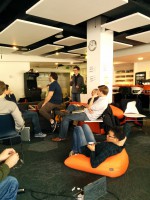The next step in my efforts to complete curl‘s HTTP/2 implementation, after having made sure downloading and uploading transfers in parallel work, was adding support for HTTP/2 server push.

A quick recap
HTTP/2 Server push is a way for the server to initiate the transfer of a resource. Like when the client asks for resource X, the server can deem that the client most probably also wants to have resource Y and Z and initiate their transfers.
The server then sends a PUSH_PROMISE to the client for the new resource and hands over a set of “request headers” that a GET for that resource could have used, and then it sends the resource in a way that it would have done if it was requested the “regular” way.
The push promise frame gives the client information to make a decision if the resource is wanted or not and it can then immediately deny this transfer if it considers it unwanted. Like in a browser case if it already has that file in its local cache or similar. If not denied, the stream has an initial window size that allows the server to send a certain amount of data before the client has to give the stream more allowance to continue.
It is also suitable to remember that server push is a new protocol feature in HTTP/2 and as such it has not been widely used yet and it remains to be seen exactly how it will become used the best way and what will turn out popular and useful. We have this “immaturity” in mind when designing this support for libcurl.
Enter libcurl
When setting up a transfer over HTTP/2 with libcurl you do it with the multi interface to make it able to work multiplexed. That way you can set up and perform any number of transfers in parallel, and if they happen to use the same host they can be done multiplexed but if they use different hosts they will use separate connections.
To the application, transfers pretty much look the same and it can remain agnostic to whether the transfer is multiplexed or not, it is just another transfer.
With the libcurl API, the application creates an “easy handle” for each transfer and it sets options in that handle for the upcoming transfer. before it adds that to the “multi handle” and then libcurl drives all those individual transfers at the same time.
Server-initiated transfers
Starting in the future version 7.44.0 – planned release date in August, the plan is to introduce the API support for server push. It couldn’t happen sooner because I missed the merge window for 7.43.0 and then 7.44.0 is simply the next opportunity. The wiki link here is however updated and reflects what is currently being implemented.
An application sets a callback to allow server pushed streams. The callback gets called by libcurl when a PUSH_PROMISE is received by the client side, and the callback can then tell libcurl if the new stream should be allowed or not. It could be as simple as this:
static int server_push_callback(CURL *parent,
CURL *easy,
size_t num_headers,
struct curl_pushheaders *headers,
void *userp)
{
char *headp;
size_t i;
FILE *out;
/* here's a new stream, save it in a new file for each new push */
out = fopen("push-stream", "wb");
/* write to this file */
curl_easy_setopt(easy, CURLOPT_WRITEDATA, out);
headp = curl_pushheader_byname(headers, ":path");
if(headp)
fprintf(stderr, "The PATH is %s\n", headp);
return CURL_PUSH_OK;
}
The callback would instead return CURL_PUSH_DENY if the stream isn’t desired. If no callback is set, no pushes will be accepted.
An interesting effect of this API is that libcurl now creates and adds easy handles to the multi handle by itself when the callback okeys it, so there will be more easy handles to cleanup at the end of the operations than what the application added. Each pushed transfer needs get cleaned up by the application that “inherits” the ownership of the transfer and the easy handle for it.
PUSH_PROMISE headers
The headers passed along in that frame will contain the mandatory “special” request ones (“:method”, “:path”, “:scheme” and “:authority”) but other than those it really isn’t certain which other headers servers will provide and how this will work. To prepare for this fact, we provide two accessor functions for the push callback to access all PUSH_PROMISE headers libcurl received:
- curl_pushheader_byname() lets the callback get the contents of a specific header. I imagine that “:path” for example is one of those that most typical push callbacks will want to take a closer look at.
- curl_pushheader_bynum() allows the function to iterate over all received headers and do whatever it needs to do, it gets the full header by index.
These two functions are also somewhat special and new in the libcurl world since they are only possible to use from within this particular callback and they are invalid and wrong to use in any and all other contexts.
HTTP/2 headers are compressed on the wire using HPACK compression, but when access from this callback all headers use the familiar HTTP/1.1 style of “name:value”.
Work in progress
 As I mentioned above already, this is work in progress and I welcome all and any comments or suggestions on how this API can be improved or tweaked to even better fit your needs. Implementing features such as these usually turn out better when there are users trying them out before they are written in stone.
As I mentioned above already, this is work in progress and I welcome all and any comments or suggestions on how this API can be improved or tweaked to even better fit your needs. Implementing features such as these usually turn out better when there are users trying them out before they are written in stone.
To try it out, build a libcurl from the http2-push branch:
https://github.com/bagder/curl/commits/http2-push
And while there are docs and an example in that branch already, you may opt to read the wiki version of the docs:
https://github.com/bagder/curl/wiki/HTTP-2-Server-Push
The best way to send your feedback on this is to post to the curl-library mailing list, but if you find obvious bugs or want to provide patches you can also opt to file issues or pull-requests on github.



 As I mentioned above already, this is work in progress and I welcome all and any comments or suggestions on how this API can be improved or tweaked to even better fit your needs. Implementing features such as these usually turn out better when there are users trying them out before they are written in stone.
As I mentioned above already, this is work in progress and I welcome all and any comments or suggestions on how this API can be improved or tweaked to even better fit your needs. Implementing features such as these usually turn out better when there are users trying them out before they are written in stone.





